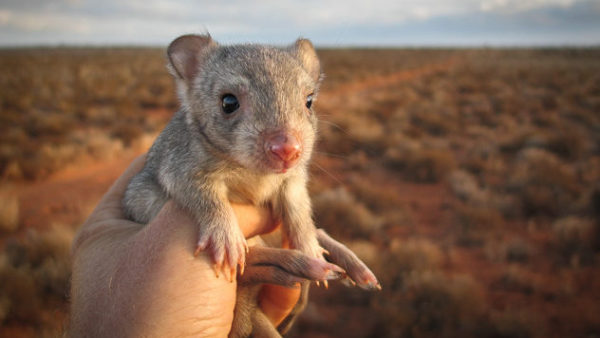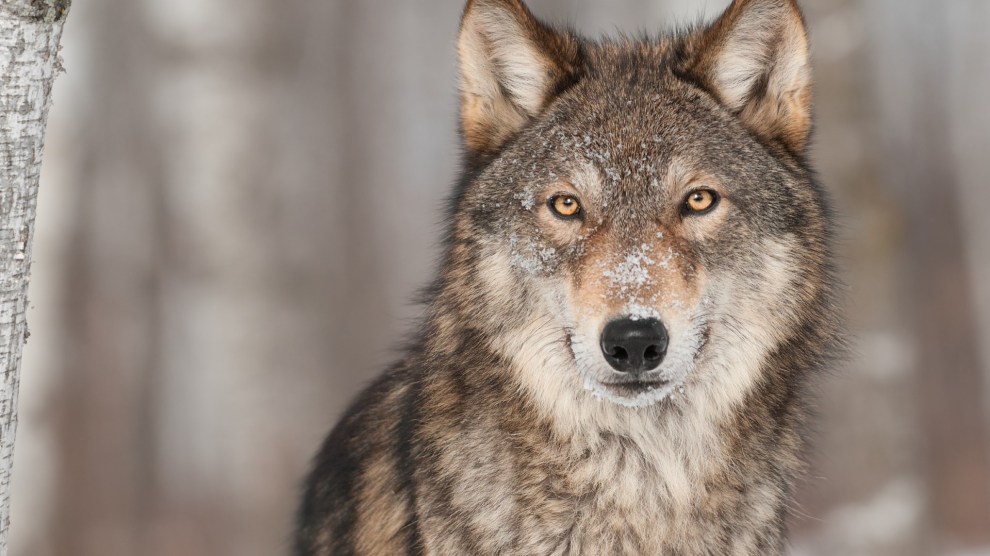
A burrowing bettong, also known as the boodie, in the Australian Outback. Australian Wildlife Society
This story was originally published by Yale Environment 360 and is reproduced here as part of the Climate Desk collaboration.
“I spent 15 years removing cats from fenced reserves and national parks,” Katherine Moseby was saying. “And then, all of a sudden, I was putting them back in. It felt very strange to be doing that.”
It was a hot, intensely blue day in the Australian Outback, about 350 miles north of Adelaide. I was tagging along with Moseby as she checked the batteries on the motion-sensitive cameras that dot Arid Recovery, an ecosystem restoration project she and her husband launched in 1997. The project sprawls over 47 square miles of red earth and scrub. It’s entirely surrounded by a six-foot-tall fence, which is designed to keep out feral cats and foxes.
Inside the main fence is a series of smaller fenced-in paddocks. Several years ago, Moseby decided to start adding cats into some of these. Her reasoning was simple and, in its own way, radical. The outback ecosystem had been so fundamentally changed, that, if the native animals were to survive, they would have to change, too. Perhaps they could be trained to avoid cats, which were introduced to the country by the British colonists and now can be found virtually everywhere in Australia, including most islands.
“A lot of the focus has been on trying to come up with methods of killing cats better,” Moseby, who holds a PhD in reintroduction biology, said. “And we sort of started looking at it from the prey perspective, like, what about if we make prey better? Will that help? Because ultimately coexistence is where we’re trying to get to. We’re not going to ever get rid of every cat in the whole of Australia.” It’s estimated that there are as many as 6 million feral cats in the country, and that they kill some 800 million native animals annually. (Foxes, also introduced by the British, are very nearly as widespread; they are somewhat easier to control, though, because they will more readily eat poison bait.)
“There’s a lot of evidence to show that evolution can occur over very short time periods, particularly when there’s strong selection,” Moseby observed.
Of course, cats and foxes are already putting strong selective pressure on Australia’s native species—so strong that many are no longer around. Among mammals, the country’s extinction rate is the highest in the world. The lesser bilby—the greater bilby’s cousin—disappeared sometime in the mid-20th century. The crescent-tailed wallaby, the desert bandicoot, and the Lake Mackay hare-wallaby vanished around the same time. All, it’s believed, were done in by introduced predators. The greater bilby, for its part, was once abundant throughout most of Australia; today the total population is estimated at fewer than 10,000. The burrowing bettong was one of the most common animals in the country; it’s now restricted to islands and reserves like Arid Recovery.
One of the reasons cats and foxes have been so deadly is they were abetted by introduced prey. European rabbits were imported to Australia in 1859; they multiplied and spread so quickly that within a few decades the population numbered in the hundreds of millions. Not only did the rabbits compete with native mammals, but also they allowed the number of cats and foxes to similarly explode. The predators could hunt native mammals to extinction and still do just fine.
“Normally, if you have a predator-prey relationship, the prey doesn’t go extinct because they rely on each other,” Moseby observed. As it was, “the cats and foxes increased into hyper-abundance.” Creatures like the lesser bilby and the desert bandicoot “didn’t have a chance to evolve because it all happened very quickly.”
The hope that motivates Moseby’s work is that given a chance, which is to say more time, species may be able to adapt to introduced predators. The results so far have offered some encouragement, but have also proved difficult to interpret.
In one experiment, Moseby and her colleagues released five cats into a fenced-in paddock with a few hundred greater bilbies and left them there for two years. They then caught some of the surviving bilbies and as well as some bilbies from a “predator-free” paddock and attached radio transmitters to their tails. The two groups of radio-tagged bilbies were transferred to another paddock with more cats. After 40 days, only a quarter of the “naïve” bilbies were still alive. By comparison, two-thirds of the “predator-exposed” bilbies had managed to avoid predation. This showed that the bilbies who’d been exposed to cats had better survival skills. But whether these skills were learned or involved selection for bilbies with more cat-savvy genes was—and remains—unclear.
Meanwhile, bettongs that were exposed to cats for 18 months showed changes in behavior that suggested they’d become more predator-wary; for instance, they approached food that had been left out for them more slowly. Once again, though, it was hard to know what these changes indicated.
“The mechanisms are there, but there’s the question: How fast can it happen?” Moseby said. “People say to me, ‘Oh, this could take a hundred years.’ And I say, ‘Yeah, it could take a hundred years. What else are you doing?’ I might not be alive to see it, but that doesn’t mean that it’s not worth doing.”

The Arid Recovery project covers 47 square miles of Australian Outback, surrounded by a 6-foot-tall fence designed to keep out feral cats and foxes.
Arid Recovery
Moseby “is the most innovative conservation scientist alive, as far as I’m concerned,” Daniel Blumstein, a professor of ecology and evolutionary biology at the University of California, Los Angeles, who has worked with her on several research papers, told me. “She is just so creative.”
Moseby’s is one of a growing number of conservation projects that proceed from the premise it’s no longer enough to protect species from change. Humans are going to have to intervene to help species change.
More than 1,000 miles northeast of Arid Recovery, at the Australian Institute of Marine Science’s National Sea Simulator, near the city of Townsville, researchers are working to produce corals that can survive warmer temperatures. The effort involves crossing corals from the central part of the Great Barrier Reef, where the water is cooler, with corals from the northern part of the reef, where it’s hotter. The offspring of these crosses are then subjected to heat stress in the labs of the Sea Simulator. The hope is that some of them will prove better able to withstand higher temperatures than either of their parents. As part of this effort, researchers are also subjecting generations of coral symbionts to heat stress, in an attempt to select for hardier varieties. (The symbionts—tiny algae from the genus Symbiodinium—provide corals with much of the food they need to build reefs.) The approach has been dubbed “assisted evolution.”
When I visited the SeaSim, as it’s called, it was coral spawning season and a post-doc named Kate Quigley was in charged of the crosses. “We’re really looking for the best of the best,” she told me.
As with bilbies and bettongs, corals are already under strong selective pressure. As the oceans warm, those that can’t take the heat are dying, while those that can persist. (According to a recent report by Australia’s ARC Centre of Excellence for Coral Reef Studies, over the past 30 years, the Great Barrier Reef has lost half of its coral populations, mainly owing to climate change.) Many scientists are skeptical that humans can really “assist” corals in the process of evolution. They note that during their annual spawning, the corals themselves perform millions upon millions of crosses; if some of the products of these unions are particularly hardy, they’ll go on to produce more corals, and evolve on their own.
Meanwhile, if the process succeeds, it won’t preserve reef diversity, but might produce the opposite: reefs dominated by a few unusually adaptable species. “One of my main objections is it’s more likely to do more harm than good,” Andrew Baird, an ecologist at James Cook University, has argued.
Then there’s the issue of scale. A few corals that can withstand higher temperatures aren’t going to repopulate the Great Barrier Reef, which is the size of Italy. To overcome this obstacle, even more radical forms of intervention would be needed. With the advent of the gene editing technology CRISPR, these are now also conceivable. If, for instance, genes associated with better heat tolerance could be identified, then corals could, in theory at least, be gene edited to carry them. Using what’s known as “gene drive” they could also, potentially, be edited to pass that trait on to their offspring. (Gene drive is a form of gene editing that overrides the normal rules of heredity.)
Already, several groups are looking into the possibility of harnessing gene drive for conservation. Genetic Biocontrol of Invasive Rodents, or GBIRd, is studying the use of gene drive to rid remote islands of rats and mice. (The group is a consortium of organizations that includes North Carolina State University, Australia’s Commonwealth Scientific and Industrial Research Organization, and New Zealand’s Biological Heritage.) Scientists in New Zealand are researching the use of gene drive to eradicate invasive wasps, and scientists at Michigan State University are investigating the possibility of using gene drive to control invasive sea lampreys in the Great Lakes. In Australia, it’s been proposed that gene drive could be used to reduce or even eliminate feral cats. Though all of these gene-drive-for-conservation projects are now in very early stages, it seems likely that, in coming years, at least some of them will prove to be workable.
The idea of using gene editing to preserve natural systems seems, from a certain perspective, crazy. What could be less natural than a creature created in a lab? And the perils of releasing gene-edited organisms—particularly those equipped with gene drive—are clearly enormous.
But at a time when the border between the natural and the manmade, the wild and the synthetic, is becoming increasingly blurred, gene editing animals to protect them—or to protect other species from them—may become increasingly appealing. Already, researchers at the SUNY College of Environmental Science and Forestry in Syracuse, New York have produced a genetically-modified American chestnut tree that’s resistant to chestnut blight, the fungal pathogen that, in the early decades of the 20th century, killed off nearly every chestnut tree in North America. (The modified tree contains a key gene borrowed from wheat.) The tree has been submitted for federal approval, and a decision is expected sometime in the next year or so.
As for “assisted evolution,” such efforts, it could be argued, were already underway long before the term was invented. The American Chestnut Foundation, for instance, has been working for decades to create a blight-resistant chestnut tree via conventional breeding methods. These trees would be hybrids—American chestnuts crossed with Chinese chestnuts—and so, they, too, would contain genes from two different species, albeit closely-related ones.













